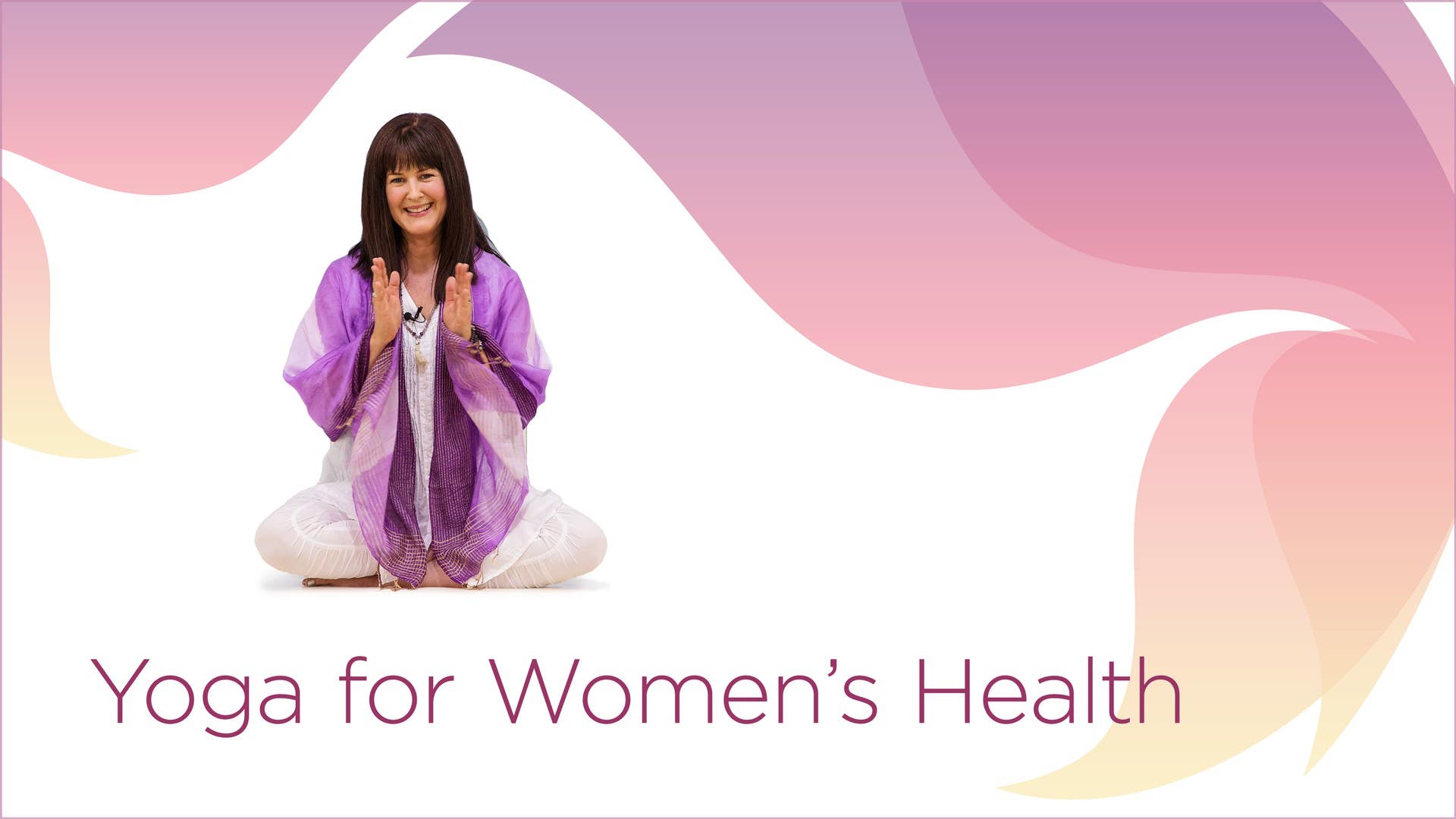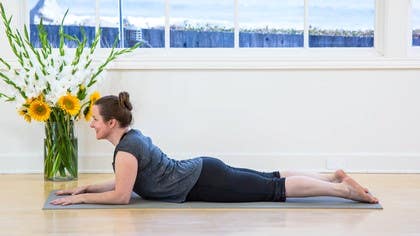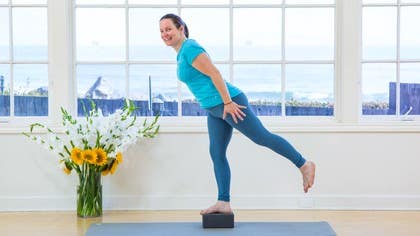Description
About This Video
Transcript
Read Full Transcript
50% of women who have had a child experience some degree of pelvic organ prolapse and some of those women don't even know. So this is pelvic organ prolapse is very common and there are different degrees. So probably if you're tuning in, you know a bit about pelvic organ prolapse and you're working with a pelvic floor physical therapist or pelvic floor physiotherapist, which I would highly recommend. The other thing that really happens is that when there's pelvic organ prolapse, it can be scary to move or to do the things, the movements that you love to do like running or biking or yoga. And so this flow has been put together so that anyone with pelvic organ prolapse can do it.
And we're still strengthening pelvic floor and doing some movements that might be a little bit more challenging. You want to check in with your healthcare provider for sure if you feel extra pressure. So let's dive in. We're going to come down to lying down on her back. You might want to have a block with you for later on, but we'll set that aside.
So coming all the way down to the back, the knees are bent here and we're going to find our transversus abdominis muscles, the ones that hug in around the side. These are sometimes called the corset muscles. So we plant the feet on the floor. We find the ASIS bones right here at the front of the pelvis. So find those bones at the very, very front of the pelvis and then walk the fingers in about two centimeters and down about two centimeters.
And that's the best place to sort of feel the transversus abdominis muscles. And on the exhale, we're going to make an S sound. So we breathe out through the mouth on the exhale sounding like this. Do that one more time. So you may have felt the transversus abdominis muscles engage there.
So then really checking in here also, is pelvis at neutral? Is it feeling like it's at neutral? So you can kind of tilt the pelvis in one direction and then the other. We know when hands placed on the pelvis here feel like they're in line. So we're keeping that low back curve, a little lumbar curve there.
And you might keep hands on the transversus abdominis muscles if that gave you some comfort. So when the transversus muscles fire, when they engage, so does pelvic floor. And this is why we're doing this movement. So we're going to slide on the exhale, we're going to slide one heel. Most of you will be like me on a sticky mat and so it might not slide that much.
So we're going to take one heel and start to extend it out to straight. And then for some of you, you might feel like I want to pause here and take an inhale and then slide again on the exhale. Or we're going to do the other side now. Exhale sliding that foot away from you and inhale and sliding it back. The exhale helps with the effort.
So if you feel like I need some extra help here, I want to exhale each time I move then we exhale slide the foot, pause there for the inhale, exhale slide again. We'll do the other side. So inhale and then exhale slide the heel. Exhale there and exhale slide the heel. Coming back to where feet are planted on the floor, bringing hands to the ribcage to hold onto the ribcage.
We're going to find ribcage breath. It might feel like you want to bring the thumbs behind fingers in front or we might just hold right onto the ribcage here. When we can hold onto the sides, we can feel that lateral movement. Exhale expanding the ribs and exhale letting the ribs come back towards themselves. So when we open up the thoracic cavity here through our inhale and we work at expanding the upper body all where the ribcage is, it can take the pressure off the pelvic floor.
And the breath is happening up here in the ribcage. Not way high up, but up here in the ribcage. So we're inhaling into the ribs and exhaling. So we know that when we engage the transversus abdominis muscles like we were just doing there, then pelvic floor engages and we don't have to give a lot of thought to that. But here are some cues that really help with pelvic floor engagement and it's very subtle.
So be gentle with yourself in this one. So we'll find the inhale here and we imagine diaphragm and pelvic floor move down on the inhale and on the exhale, if you can visualize, like you're picking a blueberry with your vagina if you're a woman. If you're a man, then you'd be walking into a cold lake. And then on the inhale, we're releasing the blueberry. So the exhale is that really gentle pick the blueberry and on the inhale, we release the blueberry.
We're not making blueberry jam, we're just picking blueberries really gentle. Another great way to engage transversus abdominis and pelvic floor is to gently, we'll pretend that we have a glass of water on one knee and then the opposite knee is just going to gently open out to the side on the exhale. So we'll inhale, bring that knee back to center unless we feel like we need the exhale again for that effort. And we'll try the other side, if we pretend that we have a glass of water on one knee, the opposite knee will open out to the side. For some of you, you're going to feel like the effort is when the knee comes back.
So then you might try inhaling as the knee opens and exhale as the knee comes back to the center. So we inhale as the knee opens, the opposite knee and exhale back to center. Great, and then we'll come back to center. Just pause there for a moment, come back to that ribcage breath. And know that these are safe movements.
This heel slide and the opening of the knee, this engages in a really gentle way. The transverse, the subdominis and the pelvic floor makes it work here. So finding your block, mine feels really far away, maybe yours is closer, and we'll bring the block underneath the sacrum. So we hold the block in one hand, press through the feet, the knees are bent, lift the pelvis up and come on to the block with the sacrum. So that's that fused bone at the base of the spine.
And we know if we're not in the right place, because it's uncomfortable, or maybe we need to get a blanket or a pillow instead or a bolster. We're going to hang out and breathe here in supported bridge. So if you imagine what's happening with diaphragm and pelvic floor, on the inhale they lower and on the exhale they come back up. So if we're dealing with pelvic organ prolapse, we can work with gravity in supported bridge where pelvic floor has a little more help on the exhale. So you might even feel that, just the release of pressure.
And you can stay in supported bridge for a while every day if that feels really good. So we find the breath here, soften pelvis, notice that exhale, maybe use a cue like picking the blueberry. Another great cue for pelvic floor, that gentle lift is the jellyfish breath. So on the inhale, we imagine the jellyfish floating down to the bottom of the ocean. And then on the exhale, jellyfish is gently lifting up.
It's really graceful. We'll press through the feet, slide the block out, lower down, notice. Then bring the block between the thighs here. Place the feet where they're comfortable and on the inhale, find an inhale here as you're down on the earth and on the exhale, lifting pelvis up. So it may help to squeeze the legs into the block as we lift.
Inhale lower down and exhale to lift. So what can be really helpful is that exhale is the effort. If we can think about that, obviously we can't do that all throughout the day, we're breathing in and out. If we set that pattern up in our body in our yoga practice, then it's there for us. So we inhale lower down and we'll remove the block, place the block over to the side.
Notice here with the pelvis how that's feeling now, find the ribcage breath. Then we're going to engage transversus abdominis. So just check in that we have that neutral pelvis here, that natural curve, the low back, that lumbar spine curve. And on the exhale, we're going to just gently lift one foot. So that might be where the heel you could choose if you felt like you needed to go back to heel slide or we start to lift that leg.
So that's our exhale. Find an inhale there and then exhale to lower that leg down. So often we get afraid of like double leg lifts but we can press one foot into the floor and on the exhale find that single leg lift. Maybe the inhale happens here before we effort again when we put the leg down. So let's try that again and we'll see how it feels when we exhale, lift the leg and inhale to lower the leg.
So we take our inhale as both feet are down, exhale to lift the leg, inhale to lower the leg. You might go back to, no, I need the exhale for each effort. We'll do that again. And eventually you may feel like I can be continuous breath through this. The exhale for the most effort where that is for you.
Great. And then we're going to roll over onto the belly. So coming down all the way onto belly, releasing down so that we make a pillow for the head with the hands, soften into the floor here. Take an inhale and on the exhale gently float above the floor. Inhale lower down and on the exhale we'll float.
And if that feels like we can go a little bit further then we might extend the arms out to straight, forehead comes down towards the floor and opposite leg, opposite arm floats up. So the exhale is where we lift, the inhale is where we lower. We'll do that. One more time each side. Good.
And then coming back where we bring the forearms down towards the floor so that the elbows are underneath the shoulders. We're going to hang out here for a moment in sphinx, feel like the low body gets really heavy towards the earth, the legs are really heavy. And then when you're ready take an inhale here, lower down a little bit towards the floor, lower your heart down towards the floor and on the exhale we'll lift the heart away from the floor, lift the abdomen away from the floor and maybe we lift the pelvis off. You might see me shaking here. On the inhale we're going to lower down so this can be a really powerful movement even though we're hardly lifting off the floor.
So on that exhale we curl in, we lengthen and on the inhale we'll come back. So it doesn't have to be a big movement to be a strengthening one. We're engaging the transversus abdominis muscles on the exhale and then we inhale and we'll release there. And then rolling back over to your back now, we're going to do one of my favorite poses when working with someone who has pelvic organ prolapse or just really feeling that movement of pelvic floor. So we're going to bring the arms overhead either in a T shape out to the sides, they can be out there, or cactus arms are right overhead.
See what works for your shoulders. On your inhale here and on the exhale we're going to lift the pelvis, we're going to leave the arms overhead, inhale lower the pelvis down on the inhale, exhale lifting the pelvis. Notice the end of the exhale before you lower down on the next inhale. We lower the pelvis down next, inhale, exhale lifting the pelvis if it feels like at any time you start to run out of breath and find your own pace with this breath, it's the inhale that lowers the pelvis down, the exhale that lifts the pelvis and we're going to notice that pause at the end of the exhale. And the next time we notice that pause at the top of our bridge, when we exhale we get to the top, see if you can, if it feels comfortable, to lower down as you've paused that exhale and then find your inhale at the bottom of the bridge where the pelvis relaxes down.
Let's try that again, exhale bringing the pelvis up, at the end of that exhale notice the pause and then start to lower down before you take your inhale, this is the very start of what we call in yoga, udiyanda, bandha and there's a little pull that happens at the pelvic floor that's actually visible if you can see on an ultrasound machine, so the exhale lift the pelvis, we pause there and we slowly lower down as we have that pause and find our inhale when we need it. We'll bring the arms down, extend it out to the sides, extend the legs out to straight and settle in for your relaxation, eyes might close or softening the eyes. Is there some way that you can make yourself a little more comfortable here, could you wiggle around, softening the face, the eyes, the jaw. If you feel like you want to stay here a little bit longer you're more than welcome to, otherwise we'll start to make small movements with fingers and toes, rotating wrists and ankles, stretching our arms up overhead, stretching out through the feet, lengthen the whole body, exhale and gently roll over to one side, pausing here for a moment, using your arms to bring you up to sitting, thank you and namaste.
Yoga for Women's Health: Yoga For Pelvic Health
Comments
Your manner is the ideal of a trauma informed practice, your languaging & openeness, a haven. Love your slight wry humour in various episodes. My body feels held in your classses.
Please do lots more classes, they’re extremely accessible to so many.
🙏🏻
Marianna - thank you so much for sharing your comment here. I am so happy to hear that you feel held in the classes with me. I would love to do more classes with YogaAnytime. They are an amazing team of caring people!
You need to be a subscriber to post a comment.
Please Log In or Create an Account to start your free trial.











